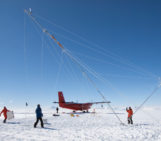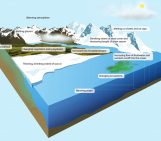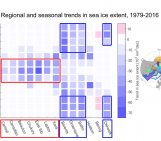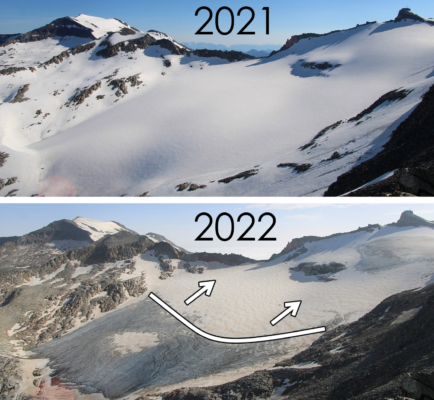
The summer of 2022 is shaping up to be a perfect storm for Alpine glaciers. By a strange coincidence, all the factors that could adversely affect glacial dynamics seem to have come into agreement. Let’s find out why.
What controls the behavior of Alpine glaciers?
Snow, temperature, weather conditions and the properties of snow and ice. These are the most important factors governing the life of a glacier. They can all vary, leading to favorable conditions for snow and ice preservation or instead accelerating their melt. In the Alps, glaciers accumulate snow during winter and spring. On the contrary during summer and early autumn, air temperature and solar radiation induce an intense melt and consumption of snow and ice. A glacier that is in equilibrium (and there are very few left now), should present a zero net mass balance at the end of the year, with an accumulation of snow compensating for the summer loss.
We all know that most glaciers are retreating, this means that the loss of ice and snow exceeds the accumulation of snow on an annual basis. Glaciologists are used to record negative mass balances in Alpine glaciers the last decades. Their hope is to record mass balances that are only slightly negative. Unfortunately, this year, unless unexpected weather turns, this will not happen. By the end of the summer, record negative balances seem to be likely.
A bad year for glaciers
In the opening picture you can see a nice re-photography of an Austrian glacier, the Kleinfleiss glacier. At first glance, you might think you are looking at a glacier in two different seasons, winter (bottom) and late summer (top). You would be wrong. The glacier is portrayed on the same day (28 June) in two different years, in 2021 (bottom) and 2022 (top). The difference is striking, isn’t it? A year ago today, the glacier was still completely covered in snow, as were the surrounding mountains. Today, it is largely uncovered, and bare ice is already exposed to the intense sunlight of the summer solstice. We are in June, but the glacier looks like it is late August. Why?
The reasons for these poor conditions are multiple:
- Little snow: This year has been incredibly snowless in the Alps, especially along its southern flank. At the end of May the observations showed a lack of snow up to -70% of the average snow depth measured on glaciers in spring. This also resulted in very low water levels of the Po-river draining the southern Alps.
- High temperature: First May and now June are proving to be particularly warm months, with several monthly temperature records broken in the Alpine countries (you can look here or here). This has made the little snow that has accumulated on the glaciers this year melt even faster.
- Saharan dust: During spring 2022, the deposition of Saharan dust on Alpine glaciers has been particularly intense with a few notable deposition episodes. This has important consequences on the conservation of snow. Dusty snow and ice are in fact darker than pristine one, absorbing a larger fraction of incoming solar radiation (the albedo feedback). This means that when snow is rich in mineral dust, it adsorbs more solar energy, accelerating melting.
Should we be worried?
The summer of 2022 promises to be very worrying for the health of Alpine glaciers. If the summer continues as it has begun, there is a risk that the graphs showing glacier balances will have to be rescaled to include data for 2022. We know that the climate is by definition a dynamic system, which occasionally manifests itself in extreme events which should happen infrequently. With glaciers, governed essentially by climatic parameters, it should be the same. Bad years, good years and sometimes unusual years, one way and the other. The really worrying thing is that the summer of 2022 could soon become the new normal due to anthropogenic climate change and this will have profound impacts, not only on glaciers.
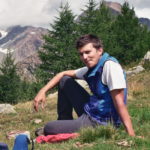 Giovanni Baccolo is a postdoc at the University of Milano-Bicocca, Italy. He studies glaciers to unveil the environmental and climatic pieces of information trapped within ice and snow. His research is mostly focused on ice geochemistry which he uses to study ice cores and supra-glacial processes. He tweets as @g_baccolo. Contact Email: giovanni.baccolo@unimib.it
Giovanni Baccolo is a postdoc at the University of Milano-Bicocca, Italy. He studies glaciers to unveil the environmental and climatic pieces of information trapped within ice and snow. His research is mostly focused on ice geochemistry which he uses to study ice cores and supra-glacial processes. He tweets as @g_baccolo. Contact Email: giovanni.baccolo@unimib.it
 Lander Van Tricht is a PhD student at the Vrije Universiteit Brussel, Belgium. His research focusses on monitoring and modelling glaciers in the Kyrgyz Tien Shan, Central-Asia. His intention is to use innovative techniques and methods, such as drones, to perform glaciological measurements. He tweets as @lander_vt and you can contact him via lander.van.tricht@vub.be
Lander Van Tricht is a PhD student at the Vrije Universiteit Brussel, Belgium. His research focusses on monitoring and modelling glaciers in the Kyrgyz Tien Shan, Central-Asia. His intention is to use innovative techniques and methods, such as drones, to perform glaciological measurements. He tweets as @lander_vt and you can contact him via lander.van.tricht@vub.be

